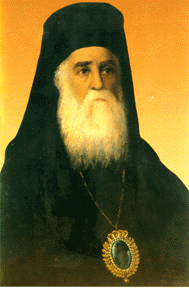Just about every Eastern Orthodox Christian Parish will have their favorite Saints. Undoubtedly, our most favorite Saint is St. Seraphim of Sarov; however, there are other Saints that we hold dear as well.
One of these wonderful Saints that we hold dear is St. Nectarios. St. Nectarios has worked many miracles for our Parish, and Diocese as well through the anointing of the faithful with the oil from the St. Nectarios Shrine. In our new church facility, we plan to have a Shrine for St. Nectarios in honor of his unceasing prayers for us to the Lord Jesus Christ. Below you will find an outline of the life of St. Nectarios.
THE LIFE OF ST. NECTARIOS
St. Nectatios was born on October 1, 1846 in Selybria in Thrace to a poor family. His given name was Anastasios Cephalas.
At the age of 14 he moved to Constantinople (Istanbul) in order to go to work and further his education.
In 1866 he moved to the island of Chios where he taught school for seven years.
St. Nectarios became a monk at the age of thirty, which is highly unusual in itself.
Three years after becoming a monk he was ordained a Deacon, taking the name Nectarios.
He graduated from the University of Athens in 1885.
During his years as a student of the University of Athens he wrote many books, pamphlets, and Bible commentaries.
Following his graduation he went to Alexandria, Egypt, where he was ordained a Priest and served the Church in Cairo with great distinction.
In recognition of his piety and brilliance as a preacher, as well as his administrative ability, he was consecrated Bishop/Metropolitan of Pentapolis by Patriarch Sophronios, which was an Egyptian See, in 1889.
He served as a Bishop in Cairo for one year, and was unjustly removed from his post by jealous clerics who envied his popularity with the people. Lies were made up about him by the jealous clergy. Patriarch Sophronios refused to listen to St. Nectarios. He was sent away from Egypt without a trial or explanation, and was never given an opportunity to defend himself.
After his dismissal, he returned to Greece in 1891, where he sought employment as a preacher. He was appointed preacher in the jurisdiction of Euboia, a large Greek island, north of Athens, where he served for two and a half years.
In 1893 he was transferred to part of the Greek mainland, west of Athens. He served as preacher there with the same great effectiveness as he had in Euboia.
In 1894 he was appointed director of Rizarios Ecclesiastical School in Athens where his service was exemplary for fifteen years.
He developed many courses of study, and wrote numerous books, all while preaching widely throughout Athens.
In 1904 at the request of several nuns, he established a monastery for them on the island of Aegina. The Monastery was named Holy Trinity Monastery.
In December of 1908, at the age of 62, St. Nectarios resigned as Director of the Theological school and withdrew to the Holy Trinity Convent on Aegina, where he lived out the rest of his life as a monk. He wrote, published, preached, and heard confessions from those who came from near and far to seek out his spiritual insights.
While at the monastery, he tended the gardens, carried stones, and helped with the construction of the Monastery buildings that were built with his own funds.
St. Nectarios died on the evening of November 9, 1920, (The day after the commemoration of St. Michael and St. Gabriel the Archangels), following hospitalization for Prostate Cancer.
His body was taken to the Holy Trinity Convent, where he was buried by a Priest-Monk named Savas, who later painted the first icon of St. Nectarios.
The funeral of St. Nectarios was attended by multitudes of people from all parts of Greece and Egypt.
Many people regarded St. Nectarios as a Saint during his lifetime because of his purity of life, virtues, the nature of his publications, as well as the miracles he performed. St. Nectarios also had a unique gift of foreknowledge.
The relics of St. Nectarios were removed from the grave on September 2, 1953. His relics gave out a beautiful fragrance.
Official recognition of Nectarios as a Saint, by the Ecumenical Patriarchate of Constantinople, took place on April 20, 1961.
The Feast Day of St. Nectarios is celebrated every year on November 9th.
There have been more than two thousand miracles attributed to the intervention of St. Nectarios.
The first miracle attributed to St. Nectarios:
During the last days of his life, the Saint was in the room for the incurables of the hospital, among many poor patients who were at the point of death. Beside the bed of St. Nectarios was a patient that had been paralyzed for years. As soon as the Saint gave up his spirit, a nurse of the hospital, together with a nun who had accompanied the Saint, began to prepare the holy body for transportation to Aegina for burial. They removed an old sweater from the Saint, and placed it for convenience on the bed of the paralytic and continued to prepare the body. Suddenly, the paralytic patient became well and rose from his bed, praising the Lord. This was the first miracle after the repose of St. Nectarios, through which the Lord confirmed the sainthood of Nectarios.
Troparion To St. Nectarios
The offspring of Selybria and the guardian of Aegina, the true friend of virtue who appeared in the last years. O Nectarios, we faithful honor you as a Godly servant of Christ. For you pour out healings of every kind for those who piously cry out, glory to Christ Who has glorified you, glory to Him Who has made you wondrous, glory to Him Who works healings for all through you.
|

